Nail psoriasis belongs to one of the varieties of the disease, which mainly affects the skin. Like other types of pathology, this form has a chronic non-infectious course of a recurrent nature. The main signs of damage to nail plates by psoriasis are a change in their shape, loss of shine, the appearance of spots on the plate, as well as complete detachment of the nail.
With this shape, the skin around the plate also suffers. Timely and incorrect treatment can provoke complications such as severe deformities and complete loss of nails on the hands and feet.
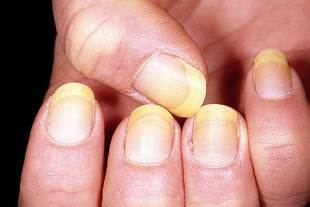
The treatment of psoriasis of the fingernails is similar to other treatments, but has its own characteristics. In the article, we will examine the symptoms, causes and treatment of psoriasis of the fingernails and toenails.
Nail damage in psoriasis can occur under the influence of various reasons. Often this form is found against the background of such a form of pathology as psoriatic arthritis.
In medical practice, this type is called nail psoriasis or psoriatic onychodystrophy. It is quite rare, but often persists with complications and many undesirable symptoms.
The following provocative factors can be attributed to the main causes of pathology:
- frequent stress and emotional stress;
- incorrect metabolic processes of the body;
- chronic infectious diseases;
- poor circulation;
- nail damage and exposure to certain chemicals;
- genetic predisposition.
Important! In some patients, nail psoriasis occurs against the background of damage to the nail plates by a bacterial infection. It is quite difficult to diagnose the disease in such cases; an experienced specialist should identify the disease.
Varieties
Psoriasis under the nails can develop in patients of different age groups, but in most cases it occurs in patients over 35-40 years old. There are several forms of the disease. These include:
Thimble Syndrome
This species is characterized by plaque lesions in the form of point incisions. Most often they are located in a certain area of the nail, but there are often cases when the grooves extend over the entire nail. Externally, the plate is similar to a finger, hence this type is often called "finger".
Onikoliza
This form has symptoms such as blurred nails, discoloration. This occurs due to the lack of healthy blood microcirculation. During the development of the disease, the plaque is distorted and disappears. Only a small part of the plate remains at the base.
Onset of bleeding
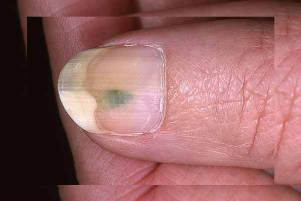
Involves the formation of red or pink spots under the nails. These symptoms occur early in the pathology. Further, signs such as the appearance of bruising under the plaque may occur. There is also a compression of the nail, its layering.
Nail psoriasis or fungus how to distinguish?
Often, patients are interested in how to distinguish nail fungus from psoriasis. This issue is quite complicated and requires consultation with a specialist. Laboratory tests are also needed. Methods such as biopsy of dermis samples, as well as histological studies, help to rule out the fungus.
Differential diagnosis can be used to rule out diseases that also affect the nails. These include the following diseases:
- lichen planus;
- various forms of dermatoses;
- eczema.
The main indicator of psoriasis is also the absence of abnormalities in the composition of the blood. An increase in the level of leukocytes, as well as erythrocyte sedimentation reactions, in most cases indicate the presence of infectious forms of pathology.
Important! The difference between nail fungus and nail psoriasis can only be detected with the help of laboratory tests. Externally, the pathologies can be almost the same.
Main manifestations of the disease
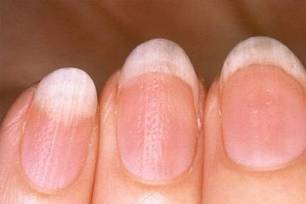
Psoriasis of the fingernails, like psoriasis of the toenails, has many very unpleasant symptoms. Below you can see photos that show what psoriasis looks like on the feet and nails. So let us consider the manifestations of the disease, depending on its form.
The thin type of psoriasis has the following symptoms:
- appearance of grooves, depressions in the form of dots;
- slab fogging;
- externally the plate bends and takes the form of a stroke;
- when pressing, pain is noticed.
Onycholysis:
- change the color of the plate;
- distortion of the nails, violation of its integrity;
- detach the plate from the body of the finger.
Hemorrhages:
- the appearance of red, brown and cyanotic stains under the nail;
- distortion of the shape of the plate, its cloud;
- capillary damage;
- purulent discharge can occur when pressed.
Symptoms may vary slightly depending on the severity of the disease and the individual patient.
How to treat nail psoriasis
The question of how to treat nail psoriasis is quite important today? In modern medical practice, there are many ways to treat the disease. The main ones include:
- using external products.
- Taking oral medication.
- Use of phototherapy and other physical treatments.
- Use of traditional medicine.
Next, we propose to examine each of the methods in more detail.
Treatment of nail psoriasis with creams and oils
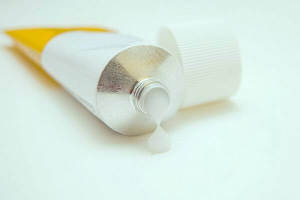
Nail psoriasis and early medication treatment involves the use of topical agents.
Ointments can be hormonal or non-hormonal. The former are used for severe forms of the disease, in cases where non-hormonal drugs are ineffective.
Ointment for psoriasis of the nails on the hands and feet may also be non-hormonal. These are medicines that include zinc, salicylic acid, etc.
Non-hormonal drugs have a minimum of side effects, they are not problematic, but their effect should wait a long time. Hormonal drugs give a quick effect, but they can cause many complications.
Oral use of medicines
Disease therapy should be comprehensive. The following remedies can also be used to eliminate the symptoms and restore the nails:
- Sedatives.
- Immunomodulators. Medications help increase a person's natural defenses.
- Antiallergic drugs.
Physiotherapy
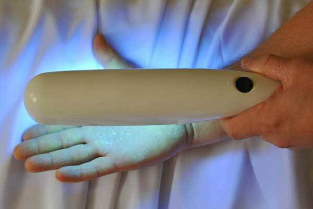
Recently, the use of physiotherapy methods has been very well proven. Ultraviolet treatment, as well as the use of methods such as cryotherapy, azone therapy, treatment with an excimer laser, gives excellent results. The following types of physical treatment are most commonly used in medical practice:
- UV radiation;
- PUVA therapy;
- X-ray therapy;
- use of ultrasound;
- laser treatment.
Important! The duration of the sessions and their number should be determined by an experienced specialist. Self-medication using these methods is strictly prohibited, as it often causes many side effects.
The Role of Traditional Medicine
Treatment with folk remedies for nail psoriasis has long been used as a complete type of therapy. So how to cure nail psoriasis at home, we will discover it below. There are many recipes to help cope with the symptoms of pathology. The most popular drugs include:
Celandine Decoration
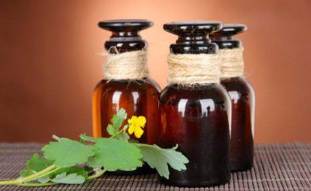
500 ml water will require 2 tbsp. lbarishteBring the agent to a boil on low heat, cook for 30-40 minutes. The broth is used for baths, it is dissolved in water in a ratio of 1: 2 and the nails are dipped in it for 20-25 minutes.
Treatment of psoriasis on nails with natural oils
Buckthorn oil relieves inflammation very well. Soothes the affected areas, enriches the nails with useful vitamins and minerals. To do this, using a cotton pad, the oil is applied to the plates and left for 30-40 minutes. The procedure is repeated 2-3 times a day.
Attention! If you decide to treat nail psoriasis yourself, consult a doctor beforehand, self-medication can harm your health!
Using the bow
Fresh onions pass through a meat grinder, the resulting particle is applied to the affected nails. I cover it with a gauze bandage and leave it for 30 minutes. The course of treatment lasts until a healthy nail grows back. Nail psoriasis is referred to as a serious chronic disease. It is very important to diagnose the disease in time and start the necessary treatment. This will help you keep your feet and hands healthy and avoid many uncomfortable complications.























